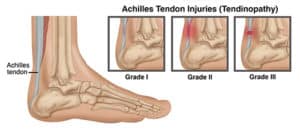Foot pain and Achilles tendon ankle pain
Achilles injury/tendinopathy
What is the Achilles tendon?
Pain experienced at the back of the ankle is often attributed to the Achilles tendon. This tendon is formed by the combination of two calf muscles: the gastrocnemius and the soleus. Despite its reputation as the strongest tendon in the body, overloading or overuse can still lead to pain and discomfort.
What is Achilles tendinopathy?
Achilles tendinopathy encompasses various conditions affecting the Achilles tendon, which connects the calf muscle to the foot via the heel bone. The suffix ‘-opathy’ indicates a tendon disorder, serving as a broad term for an array of issues that can impact this vital tendon.
The severity of Achilles tendon problems can be classified into different grades:
- Grade I: mild strain.
- Grade II: moderate strain.
- Grade III: complete rupture

What causes Achilles pain?
The cause behind this condition is referred to as Achilles tendinopathy (previously known as Achilles tendonitis, although it’s now understood that the Achilles does not become inflamed). It usually arises during activities involving running or jumping, but it can also impact individuals who are not engaged in sports. During the summer months, the incidence of tightness in the Achilles tendon tends to increase as people often wear flat sandals or flip-flops for extended periods. Such footwear puts a greater strain on the tendon, potentially leading to the development of tendinopathy. Additionally, wearing flat shoes or walking barefoot can increase pressure and tension within the Achilles tendon.
As the tendon bears excessive load, it often thickens in the middle, just above the point where it attaches to the heel bone (approximately 5 cm above). Initially, tightness and soreness are typically felt in the morning or when starting exercise. Pain may also emerge during exercise as the tendon fatigues, and it often persists even after ceasing the activity.
Insertional Achilles Pain
The complexity of this issue stems from various factors, such as tendinopathy, bursa inflammation, and heel bone pressure. Seeking guidance from a podiatrist or physiotherapist is crucial for improving the condition. If you experience specific pain where the Achilles tendon connects to the heel bone, please consult your doctor for further assistance.
How do I treat Achilles tendinopathy?
The Achilles tendon becomes both painful and thickened when it lacks the strength to handle the applied loads. Simply resting, however, will worsen the problem by further contributing to the weakness. Instead, it is advisable to avoid activities that trigger the pain. Achilles pain can often be alleviated through calf stretching exercises and simple heel drop exercises, which usually resolve the issue.
While initially painful, these exercises should be performed daily for up to three months. If daily work is causing Achilles pain, wearing shoes with a small heel or using a heel raise can help reduce the strain on the tendon. It is important to note that this alone will not eliminate the pain and must be combined with stretching exercises. Always exercise caution when stretching to avoid exacerbating the pain or risking an Achilles rupture.
Prescription orthotic insoles
Orthotic insoles are valuable tools that aid in the recovery process and help prevent future issues. At Waverley Foot Clinic, our digital assessments often uncover related factors that can be incorporated into the prescription, promoting long-term foot health and mobility. We invite you to watch the informative YouTube video below on how biomechanical assessment can accurately diagnose and effectively treat various foot pain issues.
- For more information and to explore our orthotics services, please visit here.
